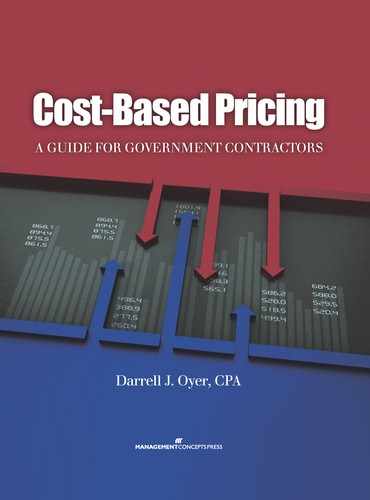CHAPTER 6
Facilities Capital Cost of Money
Facilities capital cost of money (FCCOM) is an imputed cost calculated by applying the applicable cost-of-money rate to the facilities capital employed in contract performance. The cost-of-money rate is the rate established twice per year by the Treasury Department for this purpose. The facilities capital cost is not considered a form of interest. Cost Accounting Standard (CAS) 414, Cost of Money as an Element of the Cost of Facilities Capital, establishes the basic ground rules for calculating the cost of facilities capital.
FCCOM is an outgrowth of the disallowance of interest expense in cost-based pricing under FAR Part 31. FCCOM began as a CAS standard (CAS 414) intended to compensate contractors for their investment in fixed assets and to offset the impact of any unallowable costs to purchase those assets. The offset is not direct, because a contractor may or may not have had to borrow money in order the claim FCCOM. If a contractor does not have significant investments in fixed assets, this calculation is likely not worth the efforts to claim.
The cost-of-money factors should be computed to the fifth decimal place. They are to be applied in the same manner as indirect-cost rates to recover the cost of money committed to facilities. They should be included on all contract proposals. Regardless of the applicability of CAS 414, facilities capital costs are allowable if: (1) capital investment is measured, allocated, and costed (i.e., recorded as a cost) in accordance with CAS 414; (2) adequate records are maintained to demonstrate compliance with CAS 414; (3) the cost is specifically identified in cost proposals for contracts on which it is claimed; and (4) requirements of FAR 31.205-52 on asset write-ups are observed.
Inclusion of contract clause FAR 52.215-30, Facilities Capital Cost of Money, specifically establishes the allowability of the cost of facilities capital for a specific contract (if the contractor computes such costs). If the cost is not proposed or if the contractor elects not to claim the cost, the Federal Acquisition Regulation (FAR) contract clause 52.215-31, Waiver of Facilities Capital Cost of Money, is included in the contract. Although the costs of facilities capital need not be recorded in the contractor’s books and records, memorandum records kept in sufficient detail to be verified do need to be maintained. When allowable, the costs are considered incurred for purposes of reimbursements and progress payments.
If a prospective contractor does not propose FCCOM in its offer, the contracting officer will insert the FAR clause 52.215-17, Waiver of Facilities Capital Cost of Money, in the resulting contract. Under these circumstances, cost of money is unallowable per contract terms. This is not an issue with many service contractors, which do not have significant assets that would generate a significant amount of cost of money.
The calculation of the cost of money is made using two government forms, shown in Illustrations 6-1 (from CAS 9904.414, Appendix B) and 6-2 (from DoD Forms). First, the cost-of-money rate is computed (as shown in Illustration 6-1); second, it is applied to the proposal costs (as shown in Illustration 6-2). In addition to the administrative data, the contractor must identify the cost accounting period and current cost-of-money rate in item 1 of this form. This rate is published twice per year by the Treasury Department. (Only the current rate is to be inserted—no estimates of future rates are permitted.)
For column 2 on the form, the contractor should enter the recorded net book value of the assets using the average of the balances at the beginning and end of the year for which the cost of money is being calculated. The contractor includes on separate lines the same value for assets leased under capital leases and an allocation of the net book value of corporate assets. The total of the net book value for recorded, leased, and corporate assets is assigned to each cost pool to the extent possible. However, some net book values may apply to service centers that are, in turn, allocated to the indirect-cost pools. In that instance, the net book value must be distributed to these cost pools. In Illustration 6-1, the $240,000 of net book value is distributed in column 3 to the cost pools based on their use of the service center resources. The sum of the distributed and undistributed (allocated) net book value amounts is shown in column 4. For column 5, multiply the cost-of-money rate in item 1 by the total net book value in column 4. For column 6, enter the cost allocation base for the year. For column 7, divide the amount of cost of money for each cost pool in column 5 by the allocation base for that year, which is in column 6. This is the cost-of-money rate to be applied to cost allocation bases in the price proposal.
ILLUSTRATION 6-1: Facilities Capital Cost-of-Money Factors Computation
ILLUSTRATION 6-2: Contract Facilities Capital Cost of Money
The second form (Illustration 6-2) is for the calculation of the amount for the cost of money on a specific proposal. The contractor should enter the name of each cost pool, the amount of the allocation base for the proposed work, and the cost-of-money rate from the first form. The multiplication of the base times the cost-of-money rate is the cost of money for each indirect-cost pool.
According to National Aeronautics and Space Administration regulations, when FCCOM is included as an item of cost in the contractor’s proposal, it may not be included in the cost base for calculating profit or fee. In addition, a reduction in the profit/fee objective will be made in an amount equal to the FCCOM allowed, in accordance with FAR 31.205-10(a)(2).


